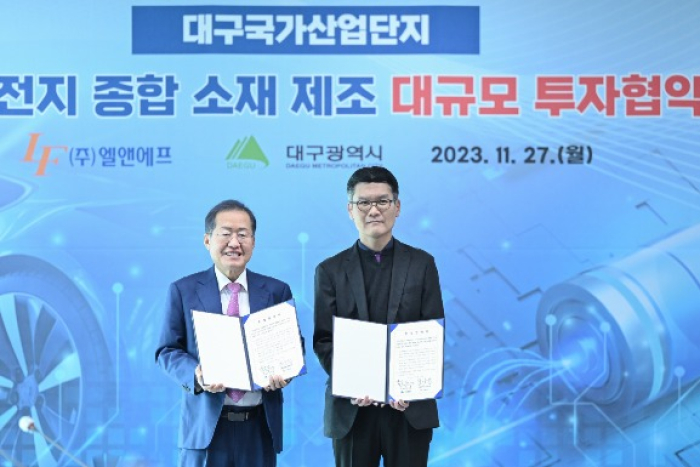News & Event
- Home
- News
- News & Event

According to The Korea Economic Daily Global Edition,
L&F Co., South Korea’s major cathode supplier seeking to transform into a comprehensive battery materials producer, will spend a total of 2.55 trillion won ($1.95 billion) to build a battery materials production cluster at home.
The Daegu-headquartered company on Monday clinched a deal with the Daegu Metropolitan Government to invest 2.55 trillion won to construct a battery materials cluster on a 559,000-square-meter site in the city, about 300 kilometers south of Seoul, L&F said.
Under the deal, it will add facilities to manufacture cathodes for lithium iron phosphate (LFP) batteries in growing demand with an annual production capacity of 160,000 tons and another plant to churn out anodes for the next-generation batteries with an annual capacity of 22,000 tons.
It will also build a new high-nickel cathode plant with a capacity of 130,000 tons after completing construction of its third cathode plant in August next year.
The newly added facilities alone are expected to generate about 9.5 trillion won in sales, which is 2.4 times more than what the company earned in sales in 2022, about 3.9 trillion won.
Combined with its existing cathode-producing plants, L&F’s total sales are forecast to grow to up to 17 trillion won, which would account for about 25% of its hometown Daegu’s gross regional domestic product.
The Korean cathode major previously invested about 1.1 trillion won to build three cathode plants on a 147,150-square-meter plot, next to the upcoming battery materials production cluster, in the city.
L&F’s aggressive investment is part of its efforts to diversify its products covering all key battery materials under the direction of its Chief Executive Officer Choi Su-an.
COMPREHENSIVE BATTERY MATERIALS PRODUCER
Its business is currently centered around cathodes, mainly nickel, cobalt, manganese and aluminum (NCMA) cathodes that are supplied to global electric vehicle giant Tesla, as well as Korea’s top three battery makers LG Energy Solution Ltd., SK On Co. and Samsung SDI Co.
It also produces the NCM cathode with high-nickel content.
In June, the company signed a memorandum of understanding with Mitsubishi Chemical Group to jointly develop next-generation anodes to enter the anode market.
Lithium-ion cells are composed of four main components – cathodes, anodes, separators and electrolytes.
Cathode-active materials make up around 40% of the cost of EV batteries while anodes account for about 15%.
The Korean cathode major’s decision to jump into anode production has also come in response to the US Inflation Reduction Act (IRA), which requires at least 40% of the value of critical minerals used in an auto batteries to be sourced from the US or one of its free trade partners to qualify for a handsome EV tax credit.
The act, designed to wean the US off the Chinese EV supply chain, eventually bars tax credits if any EV battery components are manufactured by a “foreign entity of concern,” aimed at China.
The Korean company is also seeking to produce precursors and lithium hydroxide in Korea.
Precursors make up about 70% of cathode production costs but L&F heavily relies on Chinese suppliers for its precursor needs.
Founded in 2000, L&F has rapidly grown from a small LCD backlight unit maker to a global EV battery materials maker since it started mass-producing NCM cathodes in 2007.
It developed NCMA cathodes with a 90% nickel content for the first time in the world in 2019.
The fifth-largest market-cap stock on the Kosdaq closed down 1.5% at 142,100 won per share on Monday.
Kyeong-Mook O at okmook@hankyung.com
Sookyung Seo edited this article.
Copyrights The Korea Economic Daily Global Edition. All Rights Reserved.
Reprint or redistribution without permission is prohibited.

Source: The Korea Economic Daily Global Edition (Nov. 27, 2023)